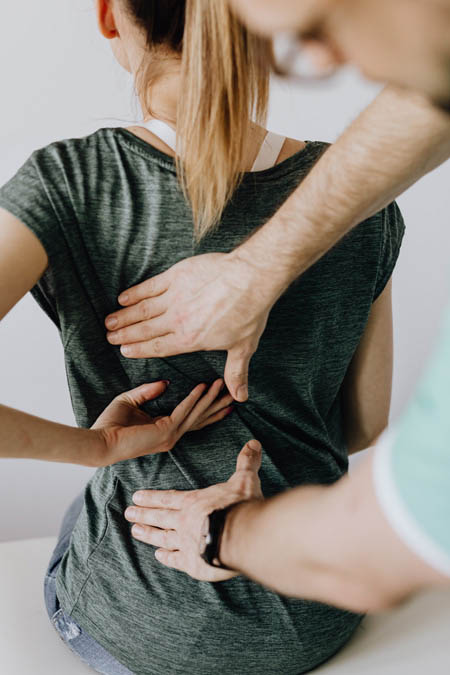 Did you break a new personal record in the deadlift, but feel like you broke something else the next morning trying to get out of bed? Did you squat the weight of Dumbo, but now feel trampled by a herd of elephants? Did you spend the weekend celebrating the local sport’s team victory by lifting too many bags of ice, but now your lower back feels hungover?
Did you break a new personal record in the deadlift, but feel like you broke something else the next morning trying to get out of bed? Did you squat the weight of Dumbo, but now feel trampled by a herd of elephants? Did you spend the weekend celebrating the local sport’s team victory by lifting too many bags of ice, but now your lower back feels hungover?
Back pain is one of the most common injuries a person experiences, but that pain doesn’t have to set you back in your health and fitness goals!
Studies show that exercise can actually reduce back pain intensity and can help prevent lower back pain when coupled with proper education.
Exercise is more effective at pain and injury prevention than back belts, shoe insoles, and ergonomic interventions! Investing in your back health doesn’t have to mean crazy contraptions or excessive medication.
What causes back pain?
“The most common reason for back pain is bending, lifting, and twisting without using the proper muscles to do those actions,” notes Anna Towne, a physical therapist at Rebound Sports and Physical Therapy.
The spine (and the erector spinae muscles that hug the spine) is part of a larger posterior chain. In addition to our backs, people should also pay attention to the strength and mobility of their hamstrings, glutes, and core.
When lifting heavy weights in the gym or twisting for the rambunctious kiddo running around your house, you are susceptible to poor form. Poor form will lead to overuse of the spine and the nagging back pain we all know too well. What do we mean by poor form? When you are relying on the strength of the spinal muscles and not recruiting the larger hamstring, glute, and core (obliques and lower abs) muscles to help.
You’ve probably heard the advice, “Don’t lift with your back, lift with your legs!” We’re twisting that rhetoric slightly: Don’t lift with your back, lift with the stabilizing muscles of the entire posterior chain!
Other back pain causes
Sometimes your back pain could stem from something larger than a strained muscle which usually resolves itself in two to three weeks. Disc injuries, muscle degeneration, and arthritis can all manifest back pain as a symptom.
“Herniated discs are usually going to be a sharp pain in the back,” says Towne who is all too familiar with the pain of herniated discs from her high school and college athlete days. “They’re often associated with nerve pain down into the glute or leg.” You may feel tingling or sharp burning down the leg, and there’s sometimes loss of strength in one or both of the lower extremities.
If you suspect that you have a herniated disc, most insurances will allow you direct access to a physical therapist without having to see a primary care doctor first. Towne advises that if you have any bladder or bowel dysfunction, you go to the emergency room instead of a Physical Therapy because that’s a common sign of a severe disc injury.
Back pain relief exercises
So how do you use exercise to prevent back pain in the future? Unfortunately, you won’t be able to find a list of exercises that are safe for all people. Depending on the severity of the back pain injury or individual mobility challenges, you may or may not be able to safely perform some exercises. You could even end up making the issue worse by following generic back advice found on the internet!
There are some general trends and recommendations, though. When you work with a physical therapist or a Genesis Health Clubs personal trainer for back pain prevention, you won’t get exercises that target only back strength.
“For someone with back problems, you’re not going to look at strengthening the back,” says former Health Engagement Coordinator at Genesis Health Clubs, Stacy Gavin. “You’re going to look at strengthening the muscles that are preventing the back from moving properly or causing the pain.”
Those muscles are the glutes, hamstrings, and core. (Remember that posterior chain concept we talked about?)
Exercises that engage the core and fire the glutes are especially important. If the glutes are working, the back won’t have to make up for the lack of effort.
That brings new meaning to a “lazy bum.” So how do you know if you have weak glutes? Dr. Towne recommends a simple exercise that is safe for all people to try out:
When you’re sitting down, try squeezing your right butt cheek. Now try squeezing the left.
Do you notice a difference? Chances are, you noticed an imbalance. Most people have asymmetry in their glutes which can cause overcompensation issues throughout the whole posterior chain. Single leg and single glute exercises are important to add to your exercise regime to help correct these imbalances but should be completed with proper instruction and they should not provoke any pain in the low back when performed. Instead of the traditional doubled-legged deadlift, switch it out for the single-leg variety with good core engagement.
Gavin’s recommended exercise is a hamstring heel-dig on an exercise ball. It’s a great exercise to activate your hamstring.

Lie on your back with one knee bent up and the other leg straight. Flex the toes of the bent knee leg toward the ceiling while also digging the heel into the ball or mat. The hamstrings should be firing to produce a contraction with this movement. Hold this contraction for 5-10 seconds and then relax. Repeat required reps and sets and perform on the opposite side.
In addition to activating the hamstring muscle, take the time to stretch the hamstring!
Tight hamstrings can alter pelvis position and cause increased low back tension and pain. Also embrace new ways to stretch your hamstrings other than the standard forward fold, which can aggravate and make back pain worse for many people.
“It’s not great to flex, extend, or twist to just get into a stretch position. There’s a lot of other ways to get stretches in and keep the back supported in a neutral position where it belongs,” says Gavin. At Genesis Health Club, you can find spacious stretching areas where you can spread out and stretch away! Just make sure you’re not overstretching (if you have over a 90-degree hamstring stretch then you do not have tight hamstrings and you do not need to continue stretching!) and make sure that you are not arching your back to get your leg higher. Once you feel the stretch, you’re good!
Healthy back lifestyle changes
In addition to Physical Therapy and Personal Training exercises that target the posterior chain, there are other lifestyle changes that you can implement to increase your odds of avoiding back re-injury in the future.
Breathing
“Breathing pattern plays a big role in back pain,” says Towne. “If you’re breathing in a position where your back is extended, you’re putting more pressure on your low spine.” Strive to breathe in a more relaxed position and let your diaphragm do the work.
Lifting Mechanics
“Having a strong core, hamstrings and glutes are very important – especially glutes,” recommends Gavin. Keeping the glutes and those other large muscles active and strong will help alleviate the back from having to do work. You’ll also probably get some nice gains in your lifts if your mechanics improve!
Posture
Have proper posture when standing and sitting. We tend to lean on our toes and stick our bottoms out without any core engagement. That changes the back structure and how our backs are bearing weight. Practice proper posture. Scrap the image of a marine standing at attention from your brain and instead focus on keeping a neutral spine, with natural spine curvatures still intact by having weight in your heels, pelvis tucked under you, and shoulders back and relaxed.
 |
 |
 |
Don’t arch your back when sitting (left) and avoid slouching and crossing your left leg over your right (middle) when sitting. To practice good posture when sitting, keep your back straight but relaxed (right)
 |
 |
Avoid the stereotypical military posture (left) and instead focus on keeping your weight in your heels, pelvis tucked under your spine, and ribs down and in (right)
Add these tools to your healthy lifestyle toolbox! In addition to the techniques above, maintaining a healthy weight, getting proper nutrition, and exercising regularly will also help prevent back pain problems in the future!
Healthy back, healthy life!
A healthy back is a back protected from injury. Strengthening the muscles surrounding the spine will keep you moving and doing the things you love.
If you are prone to back pain or want additional help preventing pain in the future, talk to any one of our Personal Trainers at Genesis Health Clubs or check out the Physical Therapy on-site and offered at select Genesis clubs! Both routes will provide you with a healthy back program with exercises tailored to you as an individual.
Otherwise, we leave you with the parting advice borrowed from our pal Sir Mixalot: Shake that healthy butt (because a healthy back means you need a healthy butt!)
